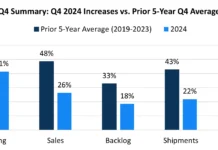by Laurie Harbour, president and CEO
Harbour Results, Inc.
Like everyone, shop owners have a more-than-full plate to deal with at work. As a result, they often spend their time addressing day-to-day business challenges and neglecting the critical activity of developing long-term strategies to drive their companies’ future success. However, the mistake many leaders make is assuming that once the plan is done and in place, the task is complete.
Now more than ever – with changes in tariffs and trade negotiations, the skilled trade gap and economic instability – a company must adjust its plan to address the current industry landscape. If company leadership doesn’t react, they are executing a plan that may not get them through current economic or geopolitical situations. To avoid this, leaders need to think of their plan as a living, evolving document that is reviewed and updated every quarter.
For example, during the past several months, there have been ongoing discussions about trade agreements and tariffs. Companies already should be taking action – by reviewing their long-term plan – to protect themselves and better plan for the future. This should include the identification of someone who can be the company expert on the trade negotiations and current and future tariffs. That individual then can provide insight into what needs to be done to sustain the company – and the company’s customers.
Make no mistake, this does not mean that when things are or appear to be stable, a company can skip reviewing its plan. During these “good times,” it’s advisable that companies “stress test” their businesses. If X happens, how will it impact the business? If a company loses 20% of its business, will it survive? As a business owner, it’s critical to be prepared for what may be lurking around the corner – expect the unexpected.
Building a foundation – the strategic plan
Before a strategic plan can be adjusted, company leadership must recognize the need for it. A strategic plan is a company’s foundation, and it equips leaders to drive efficiency and performance across the business. It’s driven by the company’s vision and mission, which describe the desired future position of the company and defines the business. Without a strategic plan, companies lose competitiveness and suffer from these four common challenges:
- Lack of direction: No vision of what the company wants to be or where it’s going; there’s an abundance of inefficiencies because everyone does what they believe is best
- Competing goals: No common, agreed-upon vision and strategy communicated throughout the company
- Disconnected leadership: Leaders keep the vision and strategy to themselves
- The wrong goal: The organization is united, but focused on the wrong goals and objectives
To identify a sound strategy, leadership must look at all aspects of the business and determine what the company does best and how to leverage those things. Key categories to consider in the strategy development process include the following:
- Purpose: Why do we do business?
- Arenas: Where will we be active?
- Vehicles: How will we get there?
- Staging: How fast and in what order will we implement activities?
- Economic logic: How do we obtain our returns?
- Differentiators: Why should customers do business with us? How will we win?
Once a strategy is in place, the business plan can be developed. Although it is not an easy task and will take time and discipline, completing the business planning process will deliver a clear roadmap for the enterprise to follow. In a recent study conducted by Harbour Results, plastics processors, die casters and stampers were asked if they had strategic plans in place. Of those who responded, 97% claimed to have overall business plans and 73% stated they have sales process plans. However, only 40% have technology improvement plans and 33% have labor and hiring plans, which are critical to the future success of the business.
It is important that companies look at the full business in developing a business plan, including the following components:
- Investment: capital, software, training
- Workforce development and succession planning
- Target industry trends
- Technology and automation
- Legislation/regulation
- Customer forecast
Communicate, communicate, communicate
Once a plan is in place, the next critical step is communicating it to the rest of the company. Research indicates that an engaged workforce is a more productive workforce, so it is important that employees not only understand business goals and the strategic plan, but their role in helping the company be successful.
This is especially important with younger members of the workforce: Approximately 40% of Gen Z and Millennials want to be engaged with and have input at their companies. So, any plans made need to take them – and their expectations – into consideration. The more they are involved, the more engaged and efficient they will be in the business.
When making communication plans, companies should remember their audience and adjust messages accordingly. Some team members may not have a business background, so a more high-level overview may be appropriate for them. Companies should consider hosting separate meetings with different levels of employees and sharing the appropriate level of detail with them. And, leadership should avoid the common mistake of communicating these key business points once. Instead, these should be integrated into other activities, such as onboarding and training, so they become engrained in employees’ minds.
And finally, as the year progresses and the plan is reviewed, company leadership should communicate with the team. This provides an opportunity to connect with them to better understand what is working and identify opportunities for improvement. Employees should be asked about which aspects of the plan should change or be improved to meet company goals.
Strategic planning is not a quick or easy task. It’s like a long voyage: A desired destination lies ahead, but the right path needs to be identified. Bumps along the road, expected or unexpected, will alter the route, but with foresight and keen driving skills, each company can reach its destination.
Laurie Harbour is president and CEO of Harbour Results, Inc., a business and operational consulting firm for the manufacturing industry, offering operational and strategic advisory expertise, as well as proprietary assessment programs, to help optimize business performance.
More information: www.harbourresults.com





